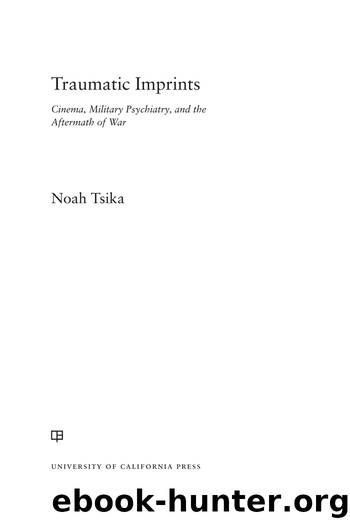Traumatic Imprints by Tsika Noah

Author:Tsika, Noah
Language: eng
Format: epub
ISBN: 9780520969926
Publisher: University of California Press
FIGURE 17. Gene Kellyâs severely disturbed sailor breaks down in the Navyâs Combat Fatigue: Irritability (1945). Courtesy of the National Archives and Records Administration.
In 1946, the mass-circulation magazine Popular Photography covered Kellyâs âprocessââwith prose that paraphrased Navy psychiatristsâin an issue that repeatedly touted the militaryâs documentary enterprise, including advertisements placed by commercial production outfits under military contract (like the Jam Handy Organization and Caravel Films).61 Presenting the actor as an agent of rehabilitation (both his own and that of his institutional counterparts), Popular Photography persistently blurred distinctions between Kelly and the role that he played, pointing to âKelly beginning to understand his problems and making a constructive effort to work [them] out.â This slippage between Kelly and a historical âcase studyâ was hardly accidental, however. It was part of a developing psychiatric doctrine that placed a premium on acting as a therapeutic exercise, and it was almost certainly prescribed as such by the public affairs strategists who, representing the interests of the Navy, shared with Popular Photography and other mass-circulation magazines information about the making of Combat Fatigue: Irritability, a docudrama whose famous lead actor provided an appealing point of entry for readers unaccustomed to coverage of âtherapeutic film.â62
As depicted in Combat Fatigue: Irritability, the function of a Navy rehabilitation center is to restore âhappy equilibriumâ to traumatized men, but the function of film acting was far less stable, if only because of the risks (Freudian and otherwise) attached to the reenactment of trauma. Popular Photography goes so far as to suggest that acting, as observed by military psychiatrists, offers a way of figuring out if a performer is âill and needs treatment.â63 Rooted in a sociological respect for the pervasiveness of role playing in everyday life, this investment in acting as a barometer of mental illness is central to the representational strategies of Combat Fatigue: Irritability, in which Kellyâs character, forced to assume the role of a war hero when visiting his demanding friends and family members, fails miserably (by, in fact, âperforming inappropriatelyâ), thus âprovingâ his need for immediate psychiatric treatment.
If Kelly passed his own performance test, simulating psychoneurosis with professional aplomb and an empathic doggedness that signaled a certain inner strength, other performers (particularly inexperienced ones) were thought to require opportunities to act precisely because they were âpsychically scarredââunable to behave ânormallyâ without guidance.64 Such men may have been monitored by those institutional agents eager to stamp out psychoneurosis, but a more generous understanding of their participation in documentary production often pivoted around an appreciation for acting not merely as a pedagogic vehicle but also as a form of occupational and recreational therapy. For professional performers like Gene Kelly, the opportunity to perform psychoneurosis in a documentary film offered challenges that were beyond the scope of commercial cinemaâand, in particular, of a Hollywood governed by the restrictions of the Production Code, which plainly forbade the sort of expletive-laden outbursts so central to Kellyâs simulation of psychosis. Kellyâs pedagogic and therapeutic turn in Combat Fatigue: Irritability, then, was understood as benefitting both the hypothetical spectator and Kelly himself.
Download
This site does not store any files on its server. We only index and link to content provided by other sites. Please contact the content providers to delete copyright contents if any and email us, we'll remove relevant links or contents immediately.
Should I Stay or Should I Go? by Ramani Durvasula(7435)
Why We Sleep: Unlocking the Power of Sleep and Dreams by Matthew Walker(6365)
Fear by Osho(4496)
Flow by Mihaly Csikszentmihalyi(4493)
Rising Strong by Brene Brown(4195)
Why We Sleep by Matthew Walker(4193)
How to Change Your Mind by Michael Pollan(4115)
Too Much and Not the Mood by Durga Chew-Bose(4098)
The Hacking of the American Mind by Robert H. Lustig(4094)
Lost Connections by Johann Hari(3929)
He's Just Not That Into You by Greg Behrendt & Liz Tuccillo(3719)
Evolve Your Brain by Joe Dispenza(3507)
The Courage to Be Disliked by Ichiro Kishimi & Fumitake Koga(3264)
Crazy Is My Superpower by A.J. Mendez Brooks(3208)
What If This Were Enough? by Heather Havrilesky(3201)
Resisting Happiness by Matthew Kelly(3200)
Descartes' Error by Antonio Damasio(3168)
The Book of Human Emotions by Tiffany Watt Smith(3145)
In Cold Blood by Truman Capote(3141)
